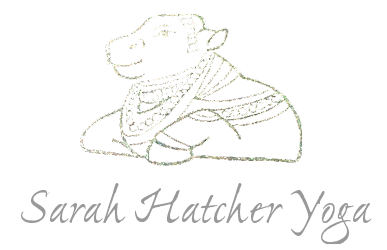Daily Practical Practice

Dashiel Peter says, "Hello out there from bonny Scotland. I'm almost a year old!"
Often I meet people who think the practice of ashtanga vinyasa yoga is a very rigid practice that has many rules. Often they think they have to kill themselves to do it. This isn't the case at all. Daily ashtanga practice can be done with as much energy as you have to put into it, it doesn't have to be hard all of the time.
Being a new mother, I find myself happy to get on my mat to practice. I am not concerned which series I do or how "hard" I practice. Just arriving on my mat and moving and breathing every day is more than enough.
There have been times in my life where practice has been the most important daily routine and I didn't focus on anything else. And there have been other years where I practiced every day with the least amount of effort applied. Now I find myself in the middle road after swaying to both extremes. I have done bare bones practices for a length of time and I have done full throttle practices every day as well.
As a new mother, I am tired most days. To manage this and sustain a six day a week committed practice, I make a practical plan. I recommend this method for people who are working intensely, and people who are traveling. This would be great for anyone who is having a harder time than usual, dealing with challenges, or even just needing more sleep than anything else.
While we are on retreat, studying directly in India with time off from our jobs and householder commitments, and when we have carved out devoted time in our daily lives to focus just on the practice, we can study as deeply as possible with full intention on practice for hours on end. This is wonderful when this can happen and I fully urge people to dive into their inward journey as much as possible.
Having a practical practice plan balances this intensity, there must be a balance: we can't sustain deep practices over a long period of time. The body needs a break, so does the mind. Note how when practitioners study "in-depth" it isn't every day for an extended amount of time, usually it is no longer than six months.
If one WERE to practice full throttle every day, there is a higher chance of injury, quitting the practice altogether and burnout. This is what we DON'T want to do, we WANT to practice throughout our entire lives, so let's stretch it out over time and with ease.

Chakra Bandhasana with David Garrigues in 2011. One of the very few photos I have of DG assisting me.
Patanjali describes that higher awareness of the self - one of the foundational aims of daily yogic practice - is very near for those who apply themselves intensely (yoga sutra 1.21: "tivrasamveganamasannah"). But it can also come to those who apply themselves with mrdu - mild effort (1.22).
In sutra 1.22, Patanjali defines three types of yogic efforts that lead one towards understanding samadhi. Practice can be mild, medium or intense; this amount of effort in turn relates to how fast or slow you understand yoga.
Another way of understanding this is that there may be a few years where you are learning intensely on a regular basis. You are living in the same town with your teacher, you are seeing them daily, or you are on retreat. Then there will be a phase where you won't be progressing so quickly. Maybe at this time you won't be learning any new "postures" but you will be finding your own understanding of the practice; here you are learning how to apply what you have been already taught. You begin to use your own language to describe it. It becomes yours. This is where you build your "bhakti muscle" as my friend Tiffany Lee says.
Then the cycle continues: you'll be there for a while until something changes again, you see your teacher and something shifts. You learn the lesson needed to be learned, and you move on. This shifting and realigning is natural. Having a few years of enjoying what you have been taught is important to practice. Don't push all of the time. Or are you that type of yogi? If we follow Patanjali's suggestion in sutra 1.22, we could have three potential practices IF we were to take the middle road.
1. Do an easy practice (a mild practice in time you spend on your mat and in effort): This practice could be twenty minutes to an hour. It is showing up and putting your time in with whatever you have in the tank to do. This could happen once or twice a week depending on how busy you are. For me this happens at least once a week: the standing and finishing asanas only - including savasana. Times that are very challenging this may be your practice - without shame or guilt. Sure it is a short one, but it is still a beautiful one.
2. Do a medium one (medium in length and in effort): This is the practice that Goldilocks would say is, "Juuuuust right". This practice is the one you try to do three to four days per week. This could be the practice you could do without working so hard but one where you have to still have to apply more effort than the first practice. One hour to an hour and a half. This is the meat of your practice - you spend most of your days doing this one - during this practice perhaps you also approach the asana you are currently working on or "stopping" at. Do this 3-4 days.
3. Enjoy a long one (intense and endurance based): This practice is the one you do one or two times per week. It is your big practice, the one that you pull everything from your tank to do. It could be an hour and a half to three hours. How much time do you have to spend on your practice? Could you turn off your phone a little earlier in the morning to make this practice happen more often? Or go to sleep much earlier?
This is the practice I try to do twice a week with the goal of doing it three times a week. For some householders with big jobs and morning commitments in the week, this could be on a Saturday or a Sunday. The reason we vary practice is so that we can:
1), focus on the breath and the vinyasa
2), maintain steadiness and consistency in our foundations
3), establish an unwavering commitment to getting on the mat six days a week
4), enjoy practicing!
To Practice
I will practice today because the day is grey
I take practice today because the day is sunny
I completed my practice today because I needed to breathe
I needed to understand myself better
My body says I need to stretch
I need to chill out
I must learn to relax
I practice because no one tells me to
I practice because I feel God watching me
Often the practice smells like the food I ate yesterday
I'm covered in sweat and I am drooling
I try to hold it together
I feel like an elephant
I am heavy
I unravel
Often during the practice
I am floating in the clouds, again with the Lord
My body is light and my mind doesn't fight
The earth enjoys my company
I join the world around me
I am taken care of
I do not have to be afraid
I love myself, my community and the blessed world
I practice because I believe in it
and it believes in me

Utthi Plutthi - one of the gestures you ALWAYS do, the last gesture before taking rest, the gesture that builds bandhas, builds bhakti, builds peace within.

